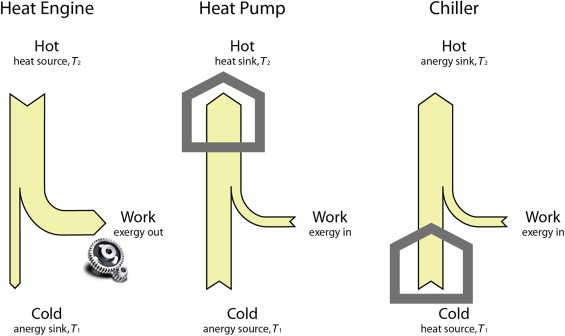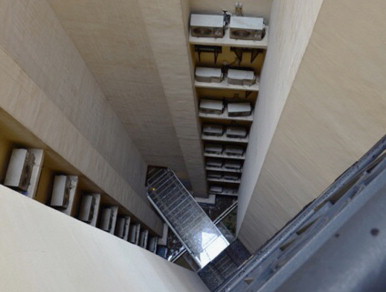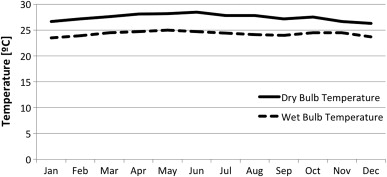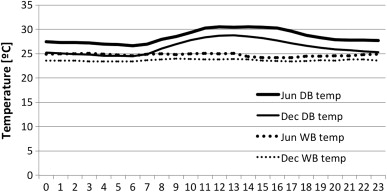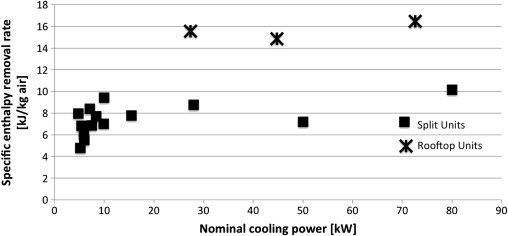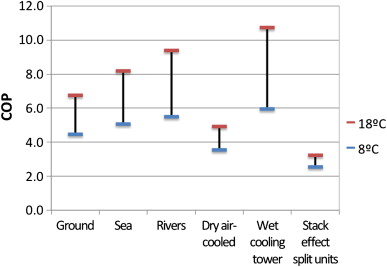Abstract
Efforts to limit CO2 emissions from buildings in the tropics either focus on reducing energy demand, i.e., air-conditioning, or on replacing fossil with renewable sources. The link between energy demand and supply is often overlooked, especially the effect of the temperature lift of air-conditioning systems on energy consumption. But while heat and humidity gains define energy demand, operating temperatures of the system define the necessary energy input. We aim to transfer our experience of using the LowEx paradigm for heat pump systems in moderate climates to the tropical climate of Singapore. In this paper, we took a systematic overview of a range of heat sinks, to which we refer to as anergy sinks. We analysed their thermal properties and their effect on the performance of air-conditioning systems, expressed as COP. The predominantly used dry air-cooled condenser units performed worst, especially when subject to a stack effect in (semi-)confined spaces. The performance is highest for cooling towers using the wet bulb temperature followed by water body based anergy sinks and the soil. The wide spread of results confirms that the heat rejection temperature is a decisive factor for the performance of the overall cooling system and the input of primary energy.
Keywords
Heat rejection ; Heat sink ; Energy efficiency ; Tropical climate ; Exergy ; Air-conditioning
1. Introduction
Building related activities—operation, construction processes and materials—account for more than 50% of anthropogenic CO2 emissions worldwide, the major driver for climate change (Meggers et al., 2012b ). While heating of buildings is the main contributor for operation related emissions in moderate climates, cooling for latent loads (dehumidification) and sensible loads (space cooling) is predominant in tropical climates like Singapore. Modern standards of comfort necessitate the dehumidification of air and the decrease of inside temperatures. This is most often done with air-conditioning systems where the incoming air is mechanically cooled until sufficient water vapour has condensed. The dehumidified air is then used for sensible cooling.
Efforts in limiting CO2 emissions from buildings concentrate on energy demand reduction. As fossil fuels still represent the bulk of energy sources used, reducing energy demand reduces carbon emissions. Another approach is to provide energy from renewable sources like sun, wind and biomass. Little consideration is given to how energy demand and supply are linked. We argue that by systems integration and by using the Low Exergy paradigm based on the thermodynamic concept of exergy, there are CO2 reduction potentials that have so far been overlooked (Meggers et al ., 2012c ; Meggers et al ., 2011 ).
Our research group is part of a research collaboration between ETH Zürich and the National Research Foundation in Singapore. We aim to transfer our experience of working in moderate climates to the tropical climate of Singapore and to adapt it for the application in the tropics. The aim of this study is to assess the influence of different, available heat sinks on the overall cooling performance.
2. Background
2.1. Low exergy and zero emission paradigm
In our research we use the exergy concept to analyse the performance of building systems with the aim of decreasing demand for high quality energy in buildings to such low levels that supply from renewable sources is economically and spatially feasible. The energy quality, i.e., exergy, needed to satisfy standards of comfort conditions at room temperature is very low and can therefore be satisfied from similarly low quality sources instead of high quality sources from combustion processes (Schmidt, 2009 ; Shukuya, 2009 ; Torio et al ., 2009 ). The LowEx paradigm acts thus on two levels: first on reducing energy demand and secondly on matching energy quality of the supply to the needed quality of the demand.
We extended this paradigm to include the notion of Zero Emission in the sense that only energy from renewable sources is allowed for the operation of buildings. As a consequence, no combustion processes are allowed in buildings, and all energy supply comes from electricity. The quest is hence to reduce the demand for electricity, which is pure exergy, to such levels that it can be supplied from renewable sources.
The term exergy was created in relation to the analysis of heat engines ( Rant, 1956 ) and is defined as the work that can be extracted from the heat flow from the warm reservoir to the cold reservoir. Its counterpart—anergy— is defined as the necessary heat flow to the cold reservoir according to the Kelvin statement of the second law of thermodynamics, Figure 1 . In the case of heat pump systems, this process is reversed: heat is extracted from an anergy source at a low temperature and then pumped to a higher temperature level with the input of exergy (Meggers and Leibundgut, 2012 ).
Symbols
AC- Air Conditioning
CFD- Computational Fluid Dynamics
COP- Coefficient of Performance
g- Exergetic efficiency of heat pump/chiller
Qc- Heat removed from cold reservoir
Qh- Heat supplied to hot reservoir
RH- Relative Humidity
T1- Temperature of cold reservoir [K]
T2- Temperature of hot reservoir [K]
W- Work consumed by heat pump/chiller
|
|
|
Figure 1. Exergy and anergy definitions for heat engine and the inverse applications heat pump and chiller. |
2.2. LowEx systems in moderate climates
Our research in moderate climates has focused on high performance heat pump systems as they allow the use of low exergy, freely available heat sources with a small input of 100% exergy usually in the form of electricity. This approach emphasises the importance of the temperature lift ∆T =T2 −T1 of heat pump systems as shown in Eq. (1) . It defines the coefficient of performance of heat pumps, based on the ideal Carnot performance. Machine inefficiencies are taken into account with the exergetic efficiency or g -value, which represents the fraction of ideal performance of the heat pump operation. It typically ranges from 0.4 to 0.6.
|
|
( 1) |
where Qh is the heat supplied to the hot reservoir [W], W is the work consumed by the chiller [W] and T1 and T2 are the temperatures of the cold and the hot reservoir [K].
This focus has led to new solutions for moderate climates with seasonal and daily variation; instead of relying on increasing the performance of passive building elements like insulation, the potential of active building components is tapped. Buildings operating at a seasonal COP of 8 and more are being tested in two major pilot projects in Zurich (Leibundgut, 2012 ; Mast et al ., 2010 ).
Our research has attempted to lower T2 as well as to increase T1 in Eq. (1) . We have developed components that operate at very low temperatures like radiant heating systems and we have explored the potential of tapping heat sources of higher temperatures for the heat pump (Meggers et al., 2012c ).
A variety of anergy sources may be used for heat pump systems: air, ground, ground water, lakes, rivers, waste heat or even hybrid solar panels (Baetschmann and Leibundgut, 2012 ; Ritter, 2010 ). Their temperature levels have an important effect on the performance increase for heating systems. Similarly, the daily and seasonal variation of sources and demand may be utilised for heating and cooling by storing heat e.g., in deep boreholes. In all these examples, the essential part is that heat is pumped in space and/ or time, which creates a relative benefit over the current, local reference environment of the building, the outside air.
2.3. LowEx tropics
By transferring these concepts to the tropical climate of Singapore, with outside air temperatures exceeding desired room temperatures all the time, the situation is inversed: heat needs to be removed from the building due to latent and sensible demand and rejected to a heat sink outside. A chiller is a reversed heat pump, so the mechanism is exactly the same: the lower the temperature lift is between the cooling system inside the building and the heat sink outside, the better is the performance of the overall system. Tropical climates have one advantage compared to moderate climates with respect to the Zero Emission goal. Different to many heating systems, cooling systems are never based on combustion processes but are already driven by electricity; an upgrade is needed but not a fundamental replacement of the system.
The COP of the chiller given in Eq. (2) is similar to Eq. (1) save that the exergy input into the chiller is detrimental and has to be rejected additionally to the cooling load:
|
|
( 2) |
where Qc is the heat removed from the cold reservoir [W], Qh is the heat supplied to the hot reservoir [W], W is the work consumed by the chiller [W], g is the exergetic efficiency of the chiller [−] and T1 and T2 are the temperatures of the cold and the hot reservoir [K].
The energy discussion in the tropics is again predominantly an efficiency discussion aiming to reduce sensible and latent cooling demand: the reduction of heat gains from solar radiation, conduction, people and other internal sources.
Transmission losses in tropical environments are not equally important as in cold climates due to the temperature gradient of 5–10 K between the inside and outside, quite different to e.g., Zurich with a gradient of 29 K at design conditions. Technical systems are thus much more important—independent of whether they are passive or active systems. The increase of performance for active systems by reducing the temperature lift is largely overlooked despite its large effect: heat gains define the thermal energy demand but the operation temperatures define the necessary energy input.
For this purpose, our research focuses on the transfer of these concepts to the tropical climate. We have established the potential benefits and have applied our concepts and technologies in a first step to the research lab BubbleZERO (Zero Emission Research Operation) that we built in Zurich and shipped to Singapore as part of our research project at the Future Cities Laboratory at the Singapore-ETH Centre (Meggers et al., 2012a ).
2.4. Heat rejection in the tropics
We have a good understanding of heat sources in moderate and cold climates and the opportunities they offer for heat pump systems. We also know about heat sinks for cooling in other climates, either as free cooling or in combination with chillers—radiant cooling to night sky, deep water cooling systems (Newman and Herbert, 2009 ), lake cooling (Bruelisauer and Leibundgut, 2009 ). Here we attempt a systematic overview of heat sinks for the tropical climate and its relevance for AC systems in this study with Singapore as a test case.
Walking around in Singapore, split type or window unit air-conditioners can be seen everywhere. These are a common visual feature of many countries with cooling demand. For aesthetic reasons, they are often placed in spaces that are quite well hidden from view, where they are often sheltered from wind. As a worst case, they are placed in confined spaces such as light shafts, see Figure 2 , creating a stack effect, so that upper condensing units have to reject heat to air already heated up further below (Bojic et al ., 2003 ; Bojic et al ., 2001 ; Choi et al ., 2005 ; Chow and Lin, 1999 ; Chow et al ., 2002 ). The AC units then operate with reduced performance and may even stop working altogether if the necessary condensation pressure cannot be reached any more.
|
|
|
Figure 2. Condenser split type units installed in a light shaft with restricted supply of fresh air, labelled “heat tower”. |
Using the wet bulb temperature, e.g., in evaporative cooling towers, is a proven way of lowering rejection temperature. Cooling towers are often used for large central installations. Even with generally high humidity in the tropics, there is still a potential for further evaporation.
3. Methodology
3.1. Climate of Singapore
The hot humid climate in Singapore can be classified as tropical rainforest climate or equatorial climate, designated Af according to the Köppen climate classification. It is characterised by uniform temperatures for the entire year (see Figure 3 ) without major climatic changes even during two monsoon periods. The reference environment for steady-state calculations is air of 28 °C, 20 g/kg absolute humidity and 84% relative humidity.
|
|
|
Figure 3. Annual variation of daily average dry bulb temperatures and wet bulb temperatures (ASHRAE, 2001 ). |
3.2. Anergy sink definition
We have been using the concept of anergy sources for heat pump applications to emphasise the use of freely available environmental heat sources ( Meggers and Leibundgut, 2012 ). Along the same lines, we now define heat sinks for chiller systems as anergy sinks . The rejected heat is dispersed to the reference environment as pure cold anergy, from which no value for cooling can be extracted.
3.3. Properties of potential anergy sinks
Table 1 gives an overview over the 6 types of anergy sink studied in this paper. The individual temperature values used for the performance calculations are described in the following sections. We used average values to describe the sink temperatures. For the condensing temperatures, we added range, approach and a heat exchanger between condenser coil and heat rejection circuit where necessary.
| Anergy sink | Tsink [°C]a | Tcondensing [°C] |
|---|---|---|
| 1 Ground | 33.5 | 39.5 |
| 2 Sea | 29.8 | 35.8 |
| 3 Rivers | 27.5 | 33.5 |
| 4 Dry air-cooled | 27.5 | 47.5 |
| 5 Wet cooling tower | 24.3 | 31.6 |
| 6 Stack effect of split units | 43.0 | 63.0 |
a. Annual average temperatures.
3.3.1. Ground/soil
Chow et al. (2011) established a calculation model for soil temperatures in Hong Kong, based on theoretical considerations and tested with actual measurements. They found a strong correlation between soil temperature and dry bulb air temperature for soils at 0.5–3 m depth. Deeper in the ground, the temperature is uniform all year round and increases with further depth according to the geothermal gradient.
There is also very little temperature variation in the soil according to Akinyemi and Mendes (2008) , based upon a theoretical model for different weather patterns. Soil surface temperatures range between 32 and 35 °C. In 20 m depth, the temperature varies between 34 and 35 °C.
3.3.2. Sea
The coastal waters around Singapore are between 10 and 30 m deep (Chia et al., 1988 ). There is no sharp fall into the deep sea that would suggest the use of deep sea cooling.
Measurements by Gin et al. (2000) showed mean temperatures in both Singapore Strait and Straits of Johor of 29.7 °C, varying very little between 27.6 °C and 32.2 °C.
3.3.3. Rivers
Singapore being an island of 778 km2 with its highest point at 164 m above sea level, there are only short rivers that run into the sea; its longest one, Kallang River, is about 10 km long. The same climatic conditions are present along the entire length of the river, thus not creating any thermal potential difference by spatial change as can be observed in different topographies. We assumed that the temperature of the rivers is defined by rain and solar radiation and thus tracks the dry bulb air temperature. The rain would follow the wet bulb temperature, as water droplets would partially evaporate and cool the droplets. Once in the slow-moving river system of Singapore, the water would be exposed to solar radiation and heat up.
3.3.4. Air
The air temperature is uniform the entire year, with average daily dry bulb temperatures remaining between 26.3 and 28.5 °C and average daily wet bulb temperatures remaining between 23.5 and 25.0 °C, see Figure 3 .
The daily range of the dry bulb temperatures are already small, with only a difference of 4 K between the hourly maximum and minimum for the months of June and December. The equivalent range for the wet bulb temperature is even smaller, with only a difference of less than 1 K between the hourly maxima and minima (see Figure 4 ). Relative humidity is 84% on average and can reach 100% during prolonged rain periods. It is generally higher in the morning and falls during the day, related to the change in dry bulb temperature and not to the change in absolute humidity, which stays almost constant between 19 and 21 g/kg.
|
|
|
Figure 4. Daily variation of average hourly dry bulb temperatures and wet bulb temperatures for June and December (ASHRAE, 2001 ). |
As discussed in 2.4, the placement of split units in (semi-) confined spaces increases the dry bulb temperature in the microclimate close to the condensing coils due to a stack effect. Priyadarsini et al. (2008) found temperatures of 38 °C through CFD modelling for Singapore, Bojic et al. (2003) found a temperature rise in the condenser flow of up to 9 °C and Chow et al. (2002) found 43 °C through CFD modelling for Hong Kong. We believed that the actual temperatures are even higher and measured them on high-rise buildings. The results will be published in a future publication. For this study, we assumed that temperatures reach 43 °C on the top of high-rise buildings.
3.4. Dry bulb vs. wet bulb temperature
The most common small-scale heat rejection units are air-cooled dry heat exchanger, Figure 2 , where the condenser coil is placed directly into the air stream. They work with sensible heat transfer only.
If water is sprayed into air at 28 °C dry bulb temperature and 84% RH without adding any energy until 100% RH is reached, the temperature drops to the wet bulb temperature of 25.5 °C. This effect could be used in an air-cooled dry heat exchanger by lowering the temperature of the incoming air by increasing the RH before the air reaches the condenser coil.
It is much more efficient to evaporate the water on the condenser coil, as it is done in evaporative heat rejection: the condenser coil is wetted and placed into an airstream that evaporates the water droplets directly off the coil, using the latent potential of water.
Most common for large applications of heat rejection is the use of a wet cooling tower. The condenser coil is cooled by circulating water that is sprayed or injected into the airstream on the top of a cooling tower. The water droplets partially evaporate and thereby cool the leftover water that is collected at the bottom of the tower. The majority of the heat is rejected by evaporation and a small part by sensible heat gain of the airstream. Evaporating 1 kg of water absorbs approximately 2400 kJ while increasing the temperature of 1 kg water by 5 K absorbs only about 21 kJ (Jones, 2001 ).
3.5. Range and approach
Cooling towers are described by the terms range and approach . The range is the temperature difference between the water inlet and exit. The approach is the difference in temperature between the recooling water temperature and the entering wet bulb temperature of air. We use these terms here for all heat sinks. The meaning of approach is thus adapted to describing the temperature difference of the cooling liquid leaving the rejection unit to the defining temperature of the anergy sink.
The range of the dry air-cooled heat rejection unit is essential in determining the coil temperature of the condenser but it is also a piece of information that is seldom published by manufacturers. We attempted to estimate it instead by calculating the specific enthalpy removal rate of the airstream:
|
|
( 3) |
where h is the enthalpy of air [kJ], mair is the mass of air [kg], is the heat removed from the air flow [W], is the volume flow [m3 /s] and ρair is the density of air [kg/m3 ].
Analysing 17 heat rejecting units (6 different product types from 3 different manufacturers) yielded an average specific enthalpy removal rate of 8 kJ/kg for split units and 16 kJ/kg for rooftop units, both of them independent of the nominal cooling power, Figure 5 . Using the specific heat capacity of air cp ≈1.0 kJ/kgK, temperature ranges of ∆T =8 K for the split units and ∆T =16 K for the rooftop units are found. We deemed it appropriate to use an average ∆T =10 K for the analysis of air-cooled dry heat exchangers.
|
|
|
Figure 5. Specific enthalpy removal rate for dry air-cooled heat exchangers, based on freely available manufacturer information. |
Jones (2001) suggested a temperature difference between the entering dry bulb temperature and the condensing temperature for dry air-cooled units of 20 K. Including the estimated 10 K temperature range, an approach of 15 K was used for dry air applications. For cooling towers, we assumed the range to be 5.5 K and the approach to be 2.5 K, based on discussions with industry representatives.
For water based and ground heat exchangers systems, we used an approach of 2 K and a temperature range of 4 K. Additionally, all systems except the dry air-cooled systems received an additional temperature increase of 2 K for an additional heat exchanger between the refrigeration liquid and a water-based heat rejection circuit.
3.6. Evaporation temperatures
Cooling in tropical climates is most often understood to be air-conditioning due to the combined need for dehumidifying inside air and cooling the interior space. Mechanical cooling works by cooling the incoming air below the dew point so that water condenses out of the airflow. The cooled air also supplies the sensible cooling load to the building. Evaporation temperatures of 8 °C are typically needed for the chiller.
We look into the feasibility of separately dealing with latent and sensible cooling loads (Meggers et al., 2012a ). The airflow is reduced to only satisfy indoor air quality criteria, reducing the amount of needed cooling with an evaporation temperature of 8 °C. The sensible cooling will be supplied with radiant cooling surfaces, resulting in an evaporation temperature of 18 °C.
3.7. Chiller performance
The calculation of the system performance is based on the definition of the COP for chillers in Eq. (2) . The g -value representing actual machine performance compared to the ideal was assumed to be 0.5, a value found for good machines ( Meggers et al., 2012c ). Due to the small variation in temperatures for the studied anergy sinks, we used average condensing temperatures T2 in combination with 8 °C and 18 °C as the evaporation temperatures T1 .
4. Results
The calculation of the chiller performance based on the anergy sink temperatures in Table 1 resulted in the COP values presented in Figure 6 . For each of the 6 types of anergy sinks studied, the COP was calculated using the range of expected evaporation temperatures.
|
|
|
Figure 6. Cooling performance (as COP of chiller) depending on the condensation temperatures of the studied anergy sinks and a bandwidth of evaporation temperatures. |
Dry air-cooled heat rejection had the lowest performance coefficient, especially when subject to a stack effect of split units. Based on the variations shown in Figure 4 , the COP does not vary significantly throughout the day and remains between 3.3 and 3.6 and 4.5 and 5.1 for 8 °C and 18 °C respectively.
Using the wet bulb temperature in cooling towers showed the best performance with a COP up to double the value compared to dry air-cooling. The water body-based anergy sinks showed a higher performance potential than the soil; all of them were in-between dry- and wet bulb performance.
The effect of a higher evaporation temperature (see Section 3.6 ) increases disproportionately with lower condensing temperatures. While the performance gain for dry air heat rejection using 18 °C evaporation temperature was small compared to other anergy sinks, it was still 39% better than for the commonly used 8 °C evaporation temperature.
Table 2 shows the relative performance increase and decrease compared to the base case of using dry air-cooling with an evaporation temperature of 8 °C.
| Anergy sink | T1 =8 °C | T1 =18 °C |
|---|---|---|
| 1 Ground | 25% | 90% |
| 2 Sea | 42% | 130% |
| 3 Rivers | 55% | 164% |
| 4 Dry air-cooled | 0%a | 39% |
| 5 Wet cooling tower | 68% | 202% |
| 6 Stack effect split units | −28% | −9% |
a. Dry air-cooled heat rejection with evaporation T1 =8 °C.
5. Discussion
From a thermodynamic perspective, the tropical climate of Singapore is best described as a thermal equilibrium—there is very little temperature difference between different anergy sinks, i.e., heat sinks. All anergy sinks have reached steady-state conditions with air temperature. The seasonal and daily air temperature variation is negligible and so is the resulting variation in chiller performance.
There is a large improvement potential if we use other anergy sinks than the standard dry bulb temperature because of the non-linear nature of the COP for chillers and heat pumps. The main points on the different performance increases may be described as follows:
- Using the evaporation potential in wet cooling towers promises a major performance gain: the return temperature from the cooling tower is very low as the airflow evaporates the majority of the heat with a small sensible heat gain.
- Using water as a transport medium instead of dry air increases specific heat capacity and thus heat transfer across heat exchangers. Minimising temperature loss across heat exchangers and minimising the approach (see 3.5) is crucial in lowering the temperature lift for the overall system.
- The effect of increasing the evaporation temperatures on the supply side, i.e., high temperature cooling systems like radiant cooling panels, becomes more pronounced as the heat rejection temperatures are improved by utilising better anergy sinks.
- The detrimental effect of arranging condenser units in confined spaces is clearly shown by the calculations, based on a number of simulation studies. It shows that the microclimate around the condenser units needs to be given greater importance.
The wide spread of results confirmed our assumption that the heat rejection temperature is a decisive factor for the performance of the overall cooling system and thus the input of primary energy. This understanding of the importance of the temperature of the system components is missing in the discussion about energy efficiency of cooling systems. Cooling systems are often designed with only nominal operation conditions in mind, without considering heat rejection mechanisms and let alone temperatures. As a consequence, outdoor conditions are taken as a fixed given anergy sink. Not only are opportunities lost in exploiting better conditions on any given site but also e.g., dry air-cooled condenser units are installed in places where heat will build up, with adverse effects on their performance.
Major energy efficiency gains for the overall building design are possible if the dependencies of different system components are taken into account. The effect of these systems considerations will be studied in greater depth using our experimental laboratory BubbleZERO in Singapore (Meggers et al., 2012a ).
6. Conclusion and outlook
This study underlines the importance of the temperature lift for the performance of the overall cooling system in tropical climates like Singapore. The properties of the heat sink, i.e., the anergy sink, influence the exergy demand for the building. When we design cooling systems, we have the opportunity to select a good sink from a range of available possibilities on or near the respective site. The best performance was found when using the wet bulb temperature through evaporation in wet cooling towers. We showed that bodies of water, i.e., rivers, lakes or the sea, act as better anergy sinks than dry air.
The performances of split unit ACs need to be researched more, studying operation mode and conditions in greater depth. We found the daily temperature variation to have negligible potential to be utilised in combination with storage capacities. This may be different in other types of tropical climates that experience more temporal variation, daily and seasonally. It may be beneficial to analyse the anergy sink potential for different tropical climate profiles.
On top of a general differentiation of anergy sinks, it is the microclimate around the condensing unit that influences the chiller performance. Understanding the stack effect of split unit condensers in confined spaces is important as a reference case and to identify improvement potentials. We conducted measurements of the microclimate around split unit condensers along the entire height of high-rise buildings in Singapore. The results of these measurements will be presented in forthcoming publications.
While dry air split type units on façades represent a simple solution to reject heat, they do not allow for integrated, high performing cooling systems. To make use of a different microclimate or a wholly different anergy sink, the heat load needs to be transported in space or stored in time, necessitating a suitable infrastructure. Such infrastructures form part of our further research. These high performing systems will help to move further towards zero emission operation, at building scale as well as at block scale.
Acknowledgements
This work was established at the Singapore-ETH Centre for Global Environmental Sustainability (SEC), co-funded by the Singapore National Research Foundation (NRF) and ETH Zurich.
References
- Akinyemi and Mendes, 2008 O.D. Akinyemi, N. Mendes; Ground temperature and moisture distribution using different weather patterns.; Journal of Building Performance Simulation, 1 (2008), pp. 257–274
- ASHRAE, 2001 ASHRAE, 2001. International Weather for Energy Calculations (IWEC Weather Files).
- Baetschmann and Leibundgut, 2012 M. Baetschmann, H. Leibundgut; LowEx solar building system: integration of PV/T collectors into low exergy building systems; Energy Procedia, 30 (2012), pp. 1052–1059
- Bojic et al., 2001 M. Bojic, M. Lee, F. Yik; Flow and temperatures outside a high-rise residential building due to heat rejection by its air-conditioners; Energy and Buildings, 33 (2001), pp. 737–751
- Bojic et al., 2003 M. Bojic, F. Yik, M. Lee; Influence of air-conditioning exhaust on exterior recessed space; Building Research and Information, 31 (2003), pp. 24–33
- Bruelisauer and Leibundgut, 2009 Bruelisauer, M., Leibundgut, H., 2009. Transport of Anergy: Playground for Small ∆Ts, In: The Future for Sustainable Built Environments: Integrating the Low Exergy Approach. Presented at the Future for Sustainable Built Environments—Integrating the Low Exergy Approach. Heerlen, The Netherlands, pp. 1–1.
- Chia et al., 1988 Chia, L.S., Habibullah, K., Chou, L.M., 1988. The Coastal Environmental Profile of Singapore, ICLARM Technical Reports 21. International Center for Living Aquatic Resources Management. Manila, Philippines.
- Choi et al., 2005 S.H. Choi, K.S. Lee, B.S. Kim; Effects of stacked condensers in a high-rise apartment building; Energy, 30 (2005), pp. 968–981
- Chow and Lin, 1999 T. Chow, Z. Lin; Prediction of on-coil temperature of condensers installed at tall building re-entrant; Applied Thermal Engineering, 19 (1999), pp. 117–132
- Chow et al., 2002 T. Chow, Z. Lin, J. Liu; Effect of condensing unit layout at building re-entrant on split-type air-conditioner performance; Energy and Buildings, 34 (2002), pp. 237–244
- Chow et al., 2011 T.T. Chow, H. Long, H.Y. Mok, K.W. Li; Estimation of soil temperature profile in Hong Kong from climatic variables; Energy and Buildings, 43 (2011), pp. 3568–3575
- Gin et al., 2000 K. Gin, X. Lin, S. Zhang; Dynamics and size structure of phytoplankton in the coastal waters of Singapore; Journal of Plankton Research, 22 (2000), pp. 1465–1484
- Jones, 2001 W.P. Jones; 11—The rejection of heat from condensers and cooling towers; Air Conditioning Engineering, Butterworth-Heinemann, Oxford (2001), pp. 311–325
- Leibundgut, 2012 Leibundgut, H., 2012. LowEx Building Design für eine ZeroEmission Architecture, 1st ed. vdf Hochschulverlag AG, Zurich, Switzerland.
- Mast et al., 2010 Mast, M., Meggers, F., Baldini, L., Leibundgut, H., 2010. LowEx—refurbishement of an office building: guaranteeing comfort while minimizing exergy, In: Proceedings of Clima 2010: Sustainable Energy Use in Buildings. Antayala, Turkey.
- Meggers et al., 2012a Meggers, F., Baldini, L., Bruelisauer, M., Leibundgut, H., 2012a. Air conditioning without so much air—low exergy decentralized ventilation and radiant cooling systems, In: The 5th IBPC Organizing Committee (Ed.), Proceedings of the 5th IBPC: The Role of Building Physics in Resolving Carbon Reduction Challenge and Promoting Human Health in Buildings. Presented at the 5th International Building Physics Conference (IBPC), Kyoto, Japan, pp. 529–536.
- Meggers et al., 2011 Meggers, F., Baldini, L., Goffin, P., Mast, M., Leibundgut, H., 2011. Improving the way we improve buildings. In: Proceedings of WEC 2011. Presented at the World Engineers' Convention. Geneva, Switzerland.
- Meggers and Leibundgut, 2012 F. Meggers, H. Leibundgut; The reference environment: utilising exergy and anergy for buildings; International Journal of Exergy, 11 (2012), pp. 423–438
- Meggers et al., 2012b F. Meggers, H. Leibundgut, S. Kennedy, M. Qin, M. Schlaich, W. Sobek, M. Shukuya; Reduce CO2 from buildings with technology to zero emissions ; Sustainable Cities and Society, 2 (2012), pp. 29–36
- Meggers et al., 2012c F. Meggers, V. Ritter, P. Goffin, M. Baetschmann, H. Leibundgut; Low exergy building systems implementation; Energy, 41 (2012), pp. 48–55
- Newman and Herbert, 2009 L. Newman, Y. Herbert; The use of deep water cooling systems: two Canadian examples; Renewable Energy, 34 (2009), pp. 727–730
- Priyadarsini et al., 2008 R. Priyadarsini, N.H. Wong, K.W.D. Cheong; Microclimatic modeling of the urban thermal environment of Singapore to mitigate urban heat island; Solar Energy, 82 (2008), pp. 727–745
- Rant, 1956 Z. Rant; Exergie, ein neues Wort für technische Arbeitsfähigkeit; Forschung Im Ingenieurwesen, 22 (1956), pp. 36–37
- Ritter, 2010 Ritter, V., 2010. Increasing the Efficiency of Zero-emission Building Operation by Clustering the Service. In: Proceedings of ENHR 2010, 22nd International Housing Research Conference. Istanbul, Turkey.
- Schmidt, 2009 D. Schmidt; Low exergy systems for high-performance buildings and communities; Energy and Buildings, 41 (2009), pp. 331–336
- Shukuya, 2009 M. Shukuya; Exergy concept and its application to the built environment; Building and Environment, 44 (2009), pp. 1545–1550
- Torio et al., 2009 H. Torio, A. Angelotti, D. Schmidt; Exergy analysis of renewable energy-based climatisation systems for buildings: a critical view; Energy and Buildings, 41 (2009), pp. 248–271
Document information
Published on 12/05/17
Submitted on 12/05/17
Licence: Other
Share this document
Keywords
claim authorship
Are you one of the authors of this document?
